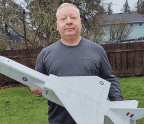UNDERSTAND YOUR RADIO

Regardless of the brand, utilizing your radio’s built-in programming helps you fly easier with better control precision of your airplane. Intended for new and intermediate fliers, this article highlights three basic features you need to understand: dual rates, exponential, and program mixing.


GETTING STARTED
First of all, when holding your radio during your flight, it’s a good idea to have the “standard” position on all switches be “away” from you. Another way to say this is to have the switches located on the top of your transmitter toward the back of the case and those on the front of the transmitter toward their top position. Establishing this allows you to always return to your most comfortable flying parameters should your flight get on the edge of your control abilities for
You’re reading a preview, subscribe to read more.
Start your free 30 days



